Qian Yang
DeepSelective: Feature Gating and Representation Matching for Interpretable Clinical Prediction
Apr 15, 2025Abstract:The rapid accumulation of Electronic Health Records (EHRs) has transformed healthcare by providing valuable data that enhance clinical predictions and diagnoses. While conventional machine learning models have proven effective, they often lack robust representation learning and depend heavily on expert-crafted features. Although deep learning offers powerful solutions, it is often criticized for its lack of interpretability. To address these challenges, we propose DeepSelective, a novel end to end deep learning framework for predicting patient prognosis using EHR data, with a strong emphasis on enhancing model interpretability. DeepSelective combines data compression techniques with an innovative feature selection approach, integrating custom-designed modules that work together to improve both accuracy and interpretability. Our experiments demonstrate that DeepSelective not only enhances predictive accuracy but also significantly improves interpretability, making it a valuable tool for clinical decision-making. The source code is freely available at http://www.healthinformaticslab.org/supp/resources.php .
How Problematic Writer-AI Interactions (Rather than Problematic AI) Hinder Writers' Idea Generation
Mar 14, 2025Abstract:Writing about a subject enriches writers' understanding of that subject. This cognitive benefit of writing -- known as constructive learning -- is essential to how students learn in various disciplines. However, does this benefit persist when students write with generative AI writing assistants? Prior research suggests the answer varies based on the type of AI, e.g., auto-complete systems tend to hinder ideation, while assistants that pose Socratic questions facilitate it. This paper adds an additional perspective. Through a case study, we demonstrate that the impact of genAI on students' idea development depends not only on the AI but also on the students and, crucially, their interactions in between. Students who proactively explored ideas gained new ideas from writing, regardless of whether they used auto-complete or Socratic AI assistants. Those who engaged in prolonged, mindless copyediting developed few ideas even with a Socratic AI. These findings suggest opportunities in designing AI writing assistants, not merely by creating more thought-provoking AI, but also by fostering more thought-provoking writer-AI interactions.
Cross-platform Prediction of Depression Treatment Outcome Using Location Sensory Data on Smartphones
Mar 10, 2025Abstract:Currently, depression treatment relies on closely monitoring patients response to treatment and adjusting the treatment as needed. Using self-reported or physician-administrated questionnaires to monitor treatment response is, however, burdensome, costly and suffers from recall bias. In this paper, we explore using location sensory data collected passively on smartphones to predict treatment outcome. To address heterogeneous data collection on Android and iOS phones, the two predominant smartphone platforms, we explore using domain adaptation techniques to map their data to a common feature space, and then use the data jointly to train machine learning models. Our results show that this domain adaptation approach can lead to significantly better prediction than that with no domain adaptation. In addition, our results show that using location features and baseline self-reported questionnaire score can lead to F1 score up to 0.67, comparable to that obtained using periodic self-reported questionnaires, indicating that using location data is a promising direction for predicting depression treatment outcome.
Enhancing Expressive Voice Conversion with Discrete Pitch-Conditioned Flow Matching Model
Feb 08, 2025



Abstract:This paper introduces PFlow-VC, a conditional flow matching voice conversion model that leverages fine-grained discrete pitch tokens and target speaker prompt information for expressive voice conversion (VC). Previous VC works primarily focus on speaker conversion, with further exploration needed in enhancing expressiveness (such as prosody and emotion) for timbre conversion. Unlike previous methods, we adopt a simple and efficient approach to enhance the style expressiveness of voice conversion models. Specifically, we pretrain a self-supervised pitch VQVAE model to discretize speaker-irrelevant pitch information and leverage a masked pitch-conditioned flow matching model for Mel-spectrogram synthesis, which provides in-context pitch modeling capabilities for the speaker conversion model, effectively improving the voice style transfer capacity. Additionally, we improve timbre similarity by combining global timbre embeddings with time-varying timbre tokens. Experiments on unseen LibriTTS test-clean and emotional speech dataset ESD show the superiority of the PFlow-VC model in both timbre conversion and style transfer. Audio samples are available on the demo page https://speechai-demo.github.io/PFlow-VC/.
Stepback: Enhanced Disentanglement for Voice Conversion via Multi-Task Learning
Jan 26, 2025Abstract:Voice conversion (VC) modifies voice characteristics while preserving linguistic content. This paper presents the Stepback network, a novel model for converting speaker identity using non-parallel data. Unlike traditional VC methods that rely on parallel data, our approach leverages deep learning techniques to enhance disentanglement completion and linguistic content preservation. The Stepback network incorporates a dual flow of different domain data inputs and uses constraints with self-destructive amendments to optimize the content encoder. Extensive experiments show that our model significantly improves VC performance, reducing training costs while achieving high-quality voice conversion. The Stepback network's design offers a promising solution for advanced voice conversion tasks.
Assessing and Learning Alignment of Unimodal Vision and Language Models
Dec 05, 2024Abstract:How well are unimodal vision and language models aligned? Although prior work have approached answering this question, their assessment methods do not directly translate to how these models are used in practical vision-language tasks. In this paper, we propose a direct assessment method, inspired by linear probing, to assess vision-language alignment. We identify that the degree of alignment of the SSL vision models depends on their SSL training objective, and we find that the clustering quality of SSL representations has a stronger impact on alignment performance than their linear separability. Next, we introduce Swift Alignment of Image and Language (SAIL), a efficient transfer learning framework that aligns pretrained unimodal vision and language models for downstream vision-language tasks. Since SAIL leverages the strengths of pretrained unimodal models, it requires significantly fewer (6%) paired image-text data for the multimodal alignment compared to models like CLIP which are trained from scratch. SAIL training only requires a single A100 GPU, 5 hours of training and can accommodate a batch size up to 32,768. SAIL achieves 73.4% zero-shot accuracy on ImageNet (vs. CLIP's 72.7%) and excels in zero-shot retrieval, complex reasoning, and semantic segmentation. Additionally, SAIL improves the language-compatibility of vision encoders that in turn enhance the performance of multimodal large language models. The entire codebase and model weights are open-source: https://lezhang7.github.io/sail.github.io/
WavChat: A Survey of Spoken Dialogue Models
Nov 26, 2024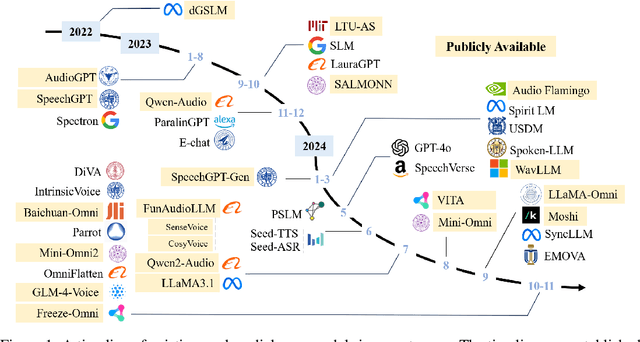

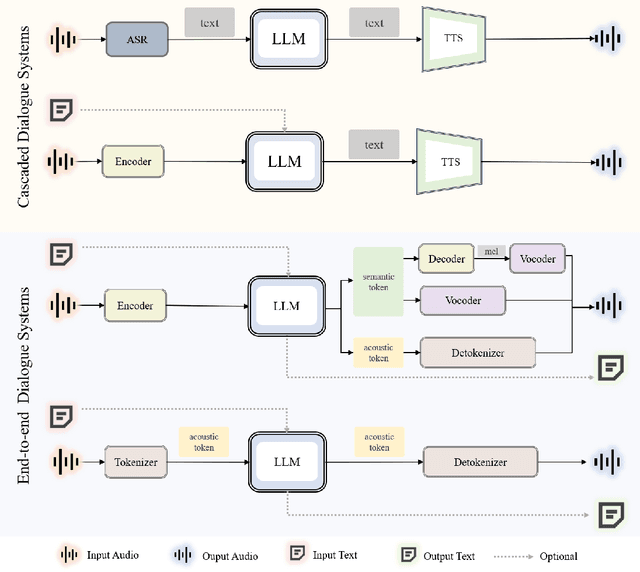
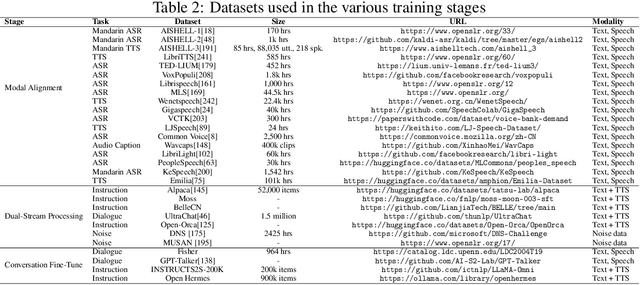
Abstract:Recent advancements in spoken dialogue models, exemplified by systems like GPT-4o, have captured significant attention in the speech domain. Compared to traditional three-tier cascaded spoken dialogue models that comprise speech recognition (ASR), large language models (LLMs), and text-to-speech (TTS), modern spoken dialogue models exhibit greater intelligence. These advanced spoken dialogue models not only comprehend audio, music, and other speech-related features, but also capture stylistic and timbral characteristics in speech. Moreover, they generate high-quality, multi-turn speech responses with low latency, enabling real-time interaction through simultaneous listening and speaking capability. Despite the progress in spoken dialogue systems, there is a lack of comprehensive surveys that systematically organize and analyze these systems and the underlying technologies. To address this, we have first compiled existing spoken dialogue systems in the chronological order and categorized them into the cascaded and end-to-end paradigms. We then provide an in-depth overview of the core technologies in spoken dialogue models, covering aspects such as speech representation, training paradigm, streaming, duplex, and interaction capabilities. Each section discusses the limitations of these technologies and outlines considerations for future research. Additionally, we present a thorough review of relevant datasets, evaluation metrics, and benchmarks from the perspectives of training and evaluating spoken dialogue systems. We hope this survey will contribute to advancing both academic research and industrial applications in the field of spoken dialogue systems. The related material is available at https://github.com/jishengpeng/WavChat.
Thoughtful Adoption of NLP for Civic Participation: Understanding Differences Among Policymakers
Oct 30, 2024



Abstract:Natural language processing (NLP) tools have the potential to boost civic participation and enhance democratic processes because they can significantly increase governments' capacity to gather and analyze citizen opinions. However, their adoption in government remains limited, and harnessing their benefits while preventing unintended consequences remains a challenge. While prior work has focused on improving NLP performance, this work examines how different internal government stakeholders influence NLP tools' thoughtful adoption. We interviewed seven politicians (politically appointed officials as heads of government institutions) and thirteen public servants (career government employees who design and administrate policy interventions), inquiring how they choose whether and how to use NLP tools to support civic participation processes. The interviews suggest that policymakers across both groups focused on their needs for career advancement and the need to showcase the legitimacy and fairness of their work when considering NLP tool adoption and use. Because these needs vary between politicians and public servants, their preferred NLP features and tool designs also differ. Interestingly, despite their differing needs and opinions, neither group clearly identifies who should advocate for NLP adoption to enhance civic participation or address the unintended consequences of a poorly considered adoption. This lack of clarity in responsibility might have caused the governments' low adoption of NLP tools. We discuss how these findings reveal new insights for future HCI research. They inform the design of NLP tools for increasing civic participation efficiency and capacity, the design of other tools and methods that ensure thoughtful adoption of AI tools in government, and the design of NLP tools for collaborative use among users with different incentives and needs.
WavTokenizer: an Efficient Acoustic Discrete Codec Tokenizer for Audio Language Modeling
Aug 29, 2024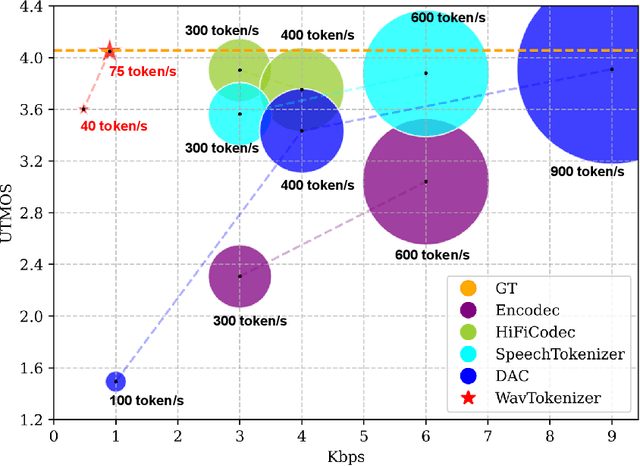
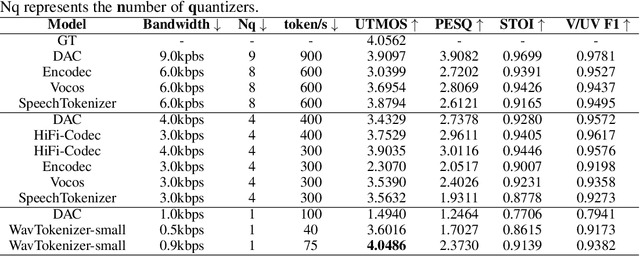

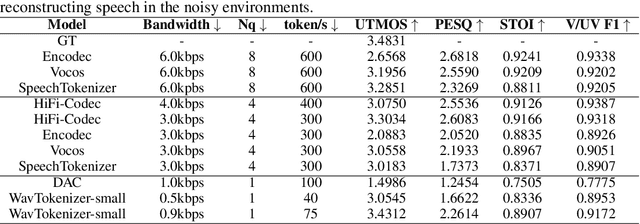
Abstract:Language models have been effectively applied to modeling natural signals, such as images, video, speech, and audio. A crucial component of these models is the codec tokenizer, which compresses high-dimensional natural signals into lower-dimensional discrete tokens. In this paper, we introduce WavTokenizer, which offers several advantages over previous SOTA acoustic codec models in the audio domain: 1)extreme compression. By compressing the layers of quantizers and the temporal dimension of the discrete codec, one-second audio of 24kHz sampling rate requires only a single quantizer with 40 or 75 tokens. 2)improved subjective quality. Despite the reduced number of tokens, WavTokenizer achieves state-of-the-art reconstruction quality with outstanding UTMOS scores and inherently contains richer semantic information. Specifically, we achieve these results by designing a broader VQ space, extended contextual windows, and improved attention networks, as well as introducing a powerful multi-scale discriminator and an inverse Fourier transform structure. We conducted extensive reconstruction experiments in the domains of speech, audio, and music. WavTokenizer exhibited strong performance across various objective and subjective metrics compared to state-of-the-art models. We also tested semantic information, VQ utilization, and adaptability to generative models. Comprehensive ablation studies confirm the necessity of each module in WavTokenizer. The related code, demos, and pre-trained models are available at https://github.com/jishengpeng/WavTokenizer.
MSceneSpeech: A Multi-Scene Speech Dataset For Expressive Speech Synthesis
Jul 19, 2024



Abstract:We introduce an open source high-quality Mandarin TTS dataset MSceneSpeech (Multiple Scene Speech Dataset), which is intended to provide resources for expressive speech synthesis. MSceneSpeech comprises numerous audio recordings and texts performed and recorded according to daily life scenarios. Each scenario includes multiple speakers and a diverse range of prosodic styles, making it suitable for speech synthesis that entails multi-speaker style and prosody modeling. We have established a robust baseline, through the prompting mechanism, that can effectively synthesize speech characterized by both user-specific timbre and scene-specific prosody with arbitrary text input. The open source MSceneSpeech Dataset and audio samples of our baseline are available at https://speechai-demo.github.io/MSceneSpeech/.
 Add to Chrome
Add to Chrome Add to Firefox
Add to Firefox Add to Edge
Add to Edge